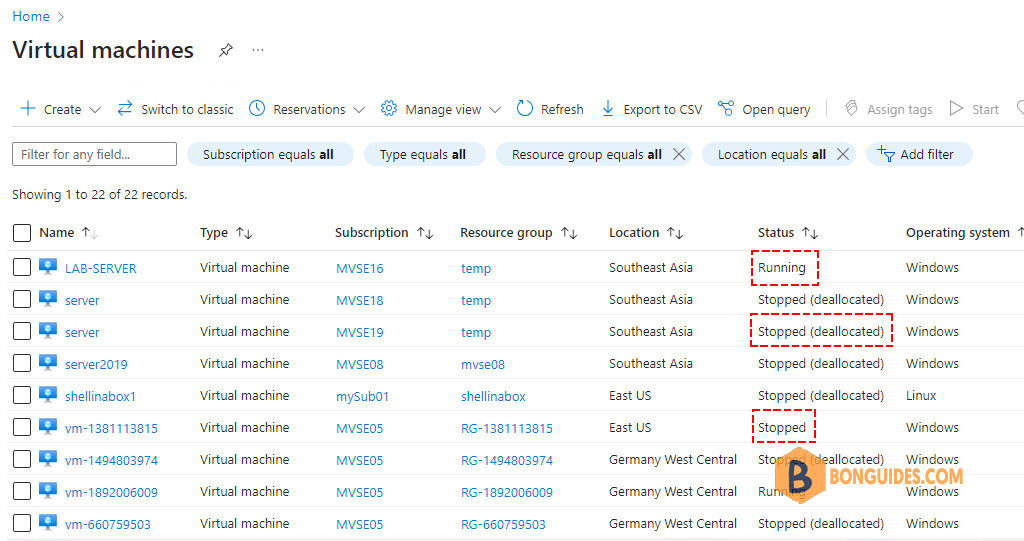Table of Contents
Check Azure VM Power State Using PowerShell
When an Azure VM is shutdown using the operating system it enters a Stopped state. In this state, the server is not running but the compute resource is still being held by Azure so you continue to get charged for that compute.
Virtual Machines should be deallocated by either stopping them in the Portal or using a PowerShell Stop-AzVM cmdlet. This article looks at how to check Azure VM power state using PowerShell.

There are the below Power State for the Azure VM:
- Starting − The virtual machine is being started.
- Running − The virtual machine is currently running
- Stopping − The virtual machine is being stopped
- Stopped − The virtual machine is currently stopped and but still incur compute charges.
- Deallocating − The virtual machine is being deallocated.
- Deallocated − The virtual machine is deallocated and released all the resources and does not incur the charges.
To check if the VMs are running, deallocated, or stopped using PowerShell, we need to use the – Status parameter. If you write only the Get-AzVM command to get the VM details, it won’t show up the Azure VM power status default.
For the specific VM power state, you need to provide a particular VM name:
Get-AzVM -VMName 'vm-1381113815' -Status | FLResourceGroupName Name Location PowerState
----------------- ---- -------- ----------
RG-1381113815 vm-1381113815 eastus VM stoppedTo check the power state of all your Azure VMs, you can use the following code snippet. It will get the properties of all VMs in a subscription then use the foreach loop to get the power state of each VM.
$array = @()
foreach ($vm in Get-AzVM) {
$object = New-Object -TypeName PSObject -Property $([ordered]@{
VMName = $vm.Name
PowerState = (Get-AzVM -VMName $($vm.Name) -Status).PowerState
ResourceGroup = $vm.ResourceGroupName
Location = $vm.Location
})
$array += $object
}
$array | Format-TableThe results might look like this:
VMName PowerState ResourceGroup Location
------ ---------- ------------- --------
vm-1381113815 VM stopped RG-1381113815 eastus
vm-7342448 VM running RG-7342448 eastus
vm-1494803974 VM deallocated RG-1494803974 germanywestcentral
vm-1892006009 VM running RG-1892006009 germanywestcentral
vm-660759503 VM deallocated RG-660759503 germanywestcentralUse the Statuses property in Get-AzVM cmdlet
Alternatively, we can use the Statuses property in Get-AzVM cmdlet to get the power states.
Get-AzVM -Name 'vm-1381113815' -ResourceGroupName 'RG-1381113815' -StatusWhen using this method, we can get more information about the virtual machine such as HyperVGeneration, Disks, Extensions and VMAgent.
ResourceGroupName : RG-1381113815
Name : vm-1381113815
HyperVGeneration : V2
Disks[0] :
Name : vm-1381113815_OsDisk_1_21997f46f7a54a72a00082cd6ccff543
Statuses[0] :
Code : ProvisioningState/succeeded
Level : Info
DisplayStatus : Provisioning succeeded
Time : 5/18/2024 2:39:18 PM
Extensions[0] :
Name : BGInfo
VMAgent :
VmAgentVersion : Unknown
Statuses[0] :
Code : ProvisioningState/Unavailable
Level : Warning
DisplayStatus : Not Ready
Message : VM Agent is unresponsive.
Time : 5/18/2024 4:05:29 PM
Statuses[0] :
Code : ProvisioningState/succeeded
Level : Info
DisplayStatus : Provisioning succeeded
Time : 5/18/2024 2:48:03 PM
Statuses[1] :
Code : PowerState/stopped
Level : Info
DisplayStatus : VM stoppedBelow is a sample PowerShell script that gets the power state of all VMs using the Statuses property:
$array = @()
foreach ($vm in Get-AzVM) {
$vmName = $vm.Name
$resourceGroup = $vm.ResourceGroupName
$vmNicName = $vm.NetworkProfile.NetworkInterfaces.Id.Split("/")[8]
$ipAddress = Get-AzPublicIpAddress | Where-Object {$_.IpConfiguration.Id -like "*$vmNicName*"}
$powerState = Get-AzVM -Name $vmName -ResourceGroupName $resourceGroup -Status | Select @{n="Status"; e={$_.Statuses[1].DisplayStatus}}
$object = New-Object -TypeName PSObject -Property $([ordered]@{
VMName = $vm.Name
PowerState = $powerState.Status
IpAddress = $ipAddress.IpAddress
ResourceGroup = $resourceGroup
Location = $vm.Location
})
$array += $object
}
$array | Format-Table# The sample output
VMName PowerState IpAddress ResourceGroup Location
------ ---------- --------- ------------- --------
vm-1381113815 VM stopped 13.90.206.15 RG-1381113815 eastus
vm-7342448 VM running 13.90.206.132 RG-7342448 eastus
vm-1494803974 VM deallocated 4.185.144.22 RG-1494803974 germanywestcentral
vm-1892006009 VM running 4.185.41.217 RG-1892006009 germanywestcentral
vm-660759503 VM deallocated 4.185.42.113 RG-660759503 germanywestcentralNot a reader? Watch this related video tutorial:





